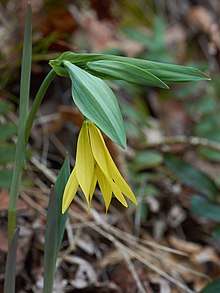Uvularia
Uvularia is a genus of flowering plants in the family Colchicaceae, which is closely related to the lily family (Liliaceae). They are commonly called bellworts, bellflowers or merrybells. The genus name is derived from the Latin ūvula meaning "little grape," likely because of the way the flowers hang downward. For the same reason Uvularia may also refer to the similarly derived palatine uvula, which hangs down from the soft palate in the mouth. The plants are often found growing on wooded slopes or in ravines and they spread by stolons,[3][4][5] or stoloniferous rhizomes.[6] The plants are usually 45–60 cm (18–24 in) in height and bear one or two flowers per stem in April and May, that hang downward from the axils of the leaves.
| Uvularia | |
|---|---|
 | |
| Uvularia grandiflora | |
| Scientific classification | |
| Kingdom: | Plantae |
| Clade: | Tracheophytes |
| Clade: | Angiosperms |
| Clade: | Monocots |
| Order: | Liliales |
| Family: | Colchicaceae |
| Genus: | Uvularia L. |
| Type species | |
| Uvularia perfoliata | |
| Synonyms[1] | |
Species
There are five species of Uvularia. All are exclusively native (endemic) to North America. They grow from northern Florida to Nova Scotia west to Manitoba and south to Texas.[1][7]
- Uvularia floridana Chapm. – Florida bellwort - FL GA SC AL MS
- Uvularia grandiflora Sm. – large-flowered bellwort - Ontario, Québec, E + C United States
- Uvularia perfoliata L. – perfoliate bellwort - Ontario, E + SC United States
- Uvularia puberula Michx. – mountain bellwort - EC United States
- Uvularia sessilifolia L. – sessile bellwort - E Canada, NE + SE United States, Great Lakes, Mississippi Valley
Description
Uvularia species are herbaceous perennials with erect, simple or twice branched stems. Leaves alternate, sessile or perfoliate. Single or sometimes paired flowers hang downward from the top of the stems appearing axillary but are in fact terminal. They bloom in spring with bell shaped flowers composed of long tepals. Fruits are three lobed, greenish to yellowish brown in color, producing 1 to 3 roundish seeds per locule.[8]
Cultivation
These unobtrusive woodland plants are used in woodland and shade gardens.[9]
References
| Wikimedia Commons has media related to Uvularia. |
| Wikispecies has information related to Uvularia |
- "Uvularia". World Checklist of Selected Plant Families (WCSP). Royal Botanic Gardens, Kew. Retrieved 2012-12-10.
- "Oakesia conradii". Tropicos. Missouri Botanical Gardens – via The Plant List.
- Hayashi, Kazuhiko; Yoshida, Seiji; Kato, Hidetoshi; Utech, Frederick H.; Whigham, Dennis F.; Kawanoi, Shoichi (1998). "Molecular Systematics of the Genus Uvularia and Selected Liliales Based upon mat K and rbc L Gene Sequence Data". Plant Species Biology. 13 (2–3): 129–146. doi:10.1111/j.1442-1984.1998.tb00254.x.
- Whigham, Dennis; Chapa, Anita (1999). "Timing and intensity of herbivory: Its influence on the performance of clonal woodland herbs". Plant Species Biology. 14 (1): 29–37. doi:10.1046/j.1442-1984.1999.00004.x.
- Kudoh, Hiroshi; Shibaike, Hiroyuki; Takasu, Hideki; Whigham, Dennis F.; Kawano, Shoichi (1999). "Gene structure and determinants of clonal structure in a temperate deciduous woodland herb, Uvularia perfoliata". Journal of Ecology. 87 (2): 244–257. doi:10.1046/j.1365-2745.1999.00355.x.
- Wijesinghe, Dushyantha K.; Whigham, Dennis F. Nutrient foraging in woodland herbs: a comparison of three species of Uvularia (Liliaceae) with contrasting belowground morphologies. P.O. Box 28, Edgewater, Maryland 21037 USA: Smithsonian Environmental Research Center. PMID 11410472.CS1 maint: location (link)
- "Uvularia". County-level distribution maps from the North American Plant Atlas (NAPA). Biota of North America Program (BONAP). 2014. Retrieved 24 May 2018.
- Utech, Frederick H.; Kawano, Shoichi (2002). "Uvularia". In Flora of North America Editorial Committee (ed.). Flora of North America North of Mexico (FNA). 26. New York and Oxford. Retrieved 24 May 2018 – via eFloras.org, Missouri Botanical Garden, St. Louis, MO & Harvard University Herbaria, Cambridge, MA.
- Charlotte Adelman; Bernard L. Schwartz (21 September 2011). The Midwestern Native Garden: Native Alternatives to Nonnative Flowers and Plants. Ohio University Press. pp. 77–. ISBN 978-0-8214-4356-9.